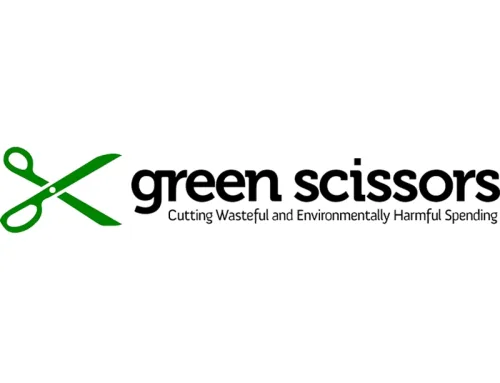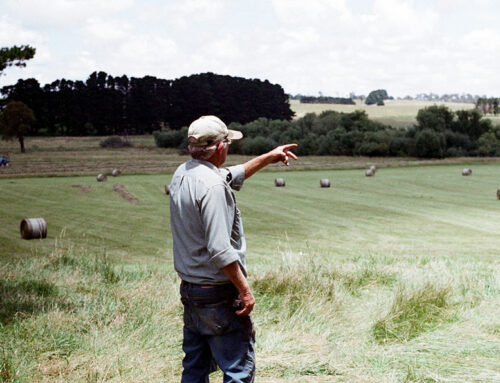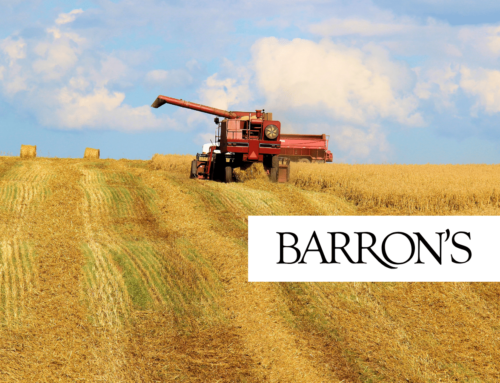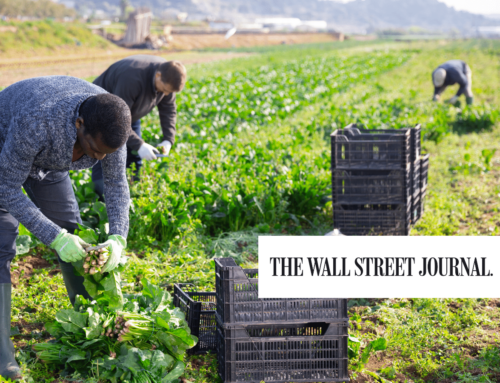Are farm subsidies wasteful spending? What impact will new economic data have on the upcoming Farm Bill reauthorization? TCS Director of Research Josh Sewell and Senior Policy Analyst Sheila Korth get their hands dirty coming up with answers.
Transcript
Announcer:
Welcome to Budget Watchdog All Federal, the podcast dedicated to making sense of the budget spending and tax issues facing the nation. Cut through the partisan rhetoric and talking points for the facts about what’s being talked about, bandied about and pushed to Washington, brought to you by taxpayers for common sense. And now the host of Budget Watchdog AF TCS President Steve Ellis.
Steve Ellis:
Welcome to All American Taxpayers Seeking Common Sense. You’ve made it to the right place for over 25 years. TCS that’s taxpayers for common sense, has served as an independent nonpartisan budget watchdog group based in Washington DC We believe in fiscal policy for America that is based on facts. We believe in transparency and accountability because no matter where you are on the political spectrum, no one wants to see their tax dollars wasted. It’s mid-February 2024 and Taylor Swift’s boyfriend’s football team won the big game. Now the fight begins to score an even bigger victory for taxpayers. Joining us to deliver our first farm bill update of the new year is Mr. Agriculture himself, TCS, director of Research and Policy, Josh Sewell, and of course the TCS, Oracle of Omaha. Sheila Korth, Senior Policy Analyst. Welcome back to the podcast, Sheila and Josh.
Josh Sewell:
Thanks Steve. It’s a great day and a great week to be here. Thanks Steve. Glad to be here.
Steve Ellis:
Leaving aside your super fandom of the Kansas City Chiefs, Josh, for budget nerds like us, last week was like Christmas in February, a double dose of economic projections in the USDA’s farm income forecast and then CBOs, long-term projections of the state of the US economy and government fiscal outlook. What’s to know here, Mr. Agriculture?
Josh Sewell:
Well, life ain’t just good in Kansas. City life is good on the farm sector. That is so USDA’s first of the year estimate anticipates 116 billion in net farm income for farmers this year. And that’s net, which remember is revenue after expenses.
Steve Ellis:
So $116 billion sounds like a good chunk of change. So this is good news, right?
Josh Sewell:
Yeah, you would think so. If it pans out, it would be right around the average annual net income that the farming sector has experienced over the last 20 years. 98.7% to be exact, but as we know, these can be revised over the year and they’re usually revised up last few years. So it should be seen as well, business as usual.
Steve Ellis:
I’ve been doing this long enough to know that something is not right. So how are the ag special interests lobbyists reacting to this?
Josh Sewell:
Oh, this is exhibit A in a mountain of evidence that we need to add tens of billions of dollars to farm subsidy programs in a new farm bill, which absolutely must pass immediately. So
Steve Ellis:
Wait, how can $116 billion, which said was basically the average of what they’ve been getting for the last 20 years, the last two decades, when even adjusted for inflation. How can that be the end of the world? Why is the sky falling? Why do they need tens of billions more, especially since farm bankruptcies have been historically low for years now
Josh Sewell:
This is farming and you know how they say there are only three guarantees in life, death taxes, and Patrick Mahomes elevating his already otherworldly talent to even more unprecedented levels in the playoffs. So a fourth should be ag industry lobbyists always demand more cash. This level of income, just so you know, is in fact, let’s be fair, a drop from recent levels. It’s actually a 25% drop from last year and a 40% drop from 2020 twos record of $196 billion.
Steve Ellis:
So wait, so the sky isn’t falling, but record income levels are,
Josh Sewell:
Yeah, record income levels of far. So we’ve fallen from a record to normal and so there’s some pains of adjustment here. So it’s a return to normal and a normal that is not crisis, but is also not massive boom times status quo, business as usual. And that’s apparently seen as caused by some of these folks to increase federal farm subsidies. It makes absolutely no sense to me or to Sheila or many others, including farmers that we talked to because of how well things have been in farm country in recent years, but also because of the other report you just mentioned.
Steve Ellis:
Alright, like you said, I said a double dose of economic projections at the top of the pod. So let’s move off the farm and look a little more globally and turn to the congressional budget offices budget and economic outlook 2024 to 2034. Report budget watchdog a F Faithful know that CBO is Congress’s nonpartisan budget, scorekeeper and prognosticator. Josh, what did CBOs crystal ball reveal?
Josh Sewell:
Well, not a surprise to us, the deficits and debt continues to be an issue. So they’re currently projecting that the deficit for 2024 is expected to be $1.6 trillion and it will say for a couple of years going down slightly, it’ll mostly increase over the next decade leading to a total of 18.9 trillion in additional debt from this year through 2033. And that would make it a grand total of 45.7 trillion in debt, which would be equal to a 114% of our economic output, at least as CBO predicts right now.
Steve Ellis:
And that is obviously, and we’ve talked about this before, levels that haven’t been seen since immediately after World War ii. Debt is a percentage of GDP and it sounds pretty scary and it is, but because I actually do read these reports before I get on the pod, it actually according to CBO is a little bit better than it was what they prognosticate in last year,
Josh Sewell:
Right? I mean, I guess it’s a silver lining for us. So CBO updates this report up to three times in a year, typically February, may and December unless something else happens, it gets sent in the way. And the last version that they got out that was really updated in May of last year, deficits have actually decreased the projected deficits by $1.4 trillion less over those 10 years. And 63 billion of that savings, or I should say it’s not savings, 63 billion of that reduced deficit that would occur just this fiscal year alone.
Steve Ellis:
Well, you got to take your silver linings where you can get it, and my guess 1.4 trillion less in dollars debt is better and 63 billion this year is great, but so what happened? Why did we get this reduction, Josh?
Josh Sewell:
So the biggest difference between May of last year and February of this year as the Fiscal responsibility Act. So that is the spending limit deal that was enacted last year in exchange for raising the debt limit. So there are some spending restraints in there for two years and CBO looks at these bills that are passed that become law. It looks at its economic projections and how those things are impacted and they say this is the difference. And so Congress making that decision to put in some restraints on parts of the budget, as long as those restraints are still there for these two fiscal years, we get a little bit of reduction in the deficit.
Steve Ellis:
So Sheila, let me bring you here on this. And so Josh mentioned about the CBO projections and how they visioned the law interacting. What are some of the limits of the CBOs projections?
Sheila Korth:
Thanks Steve for that question. It’s a great one because as we know in life or whether it’s CBO projections, that not everything always pans out how you think it’s going to pan out and there might be twists and turns along the way. So when CBO comes out with these projections, as Josh said, multiple times a year, they assume that certain things are going to happen, that interest rates are going to remain where they are, are slightly adjusted depending on what’s going to happen with the economy, for instance. But what CBO says, actually in their report, they say that they assume that current laws governing taxes and spending are going to generally remain unchanged. And so they build that into their economic projections moving forward. But as we know in real life that things change, you have things like COVID-19 pandemics, you have disasters, you have economic recessions, things that the impact the economy and how much revenue that the federal government is bringing in, for instance, to affect that deficit or the national debt. And so as Josh said, we’ll look at these reports later in the year and see if things have changed, but there’s a lot of assumptions that don’t always pan out in real life.
Steve Ellis:
And so you mentioned that they have to assume current law and they do have to assume current law. They can’t say, Hey, we know passes prologue and these tax cuts that are expiring in 2026 and 2027 that they’re going to get renewed in some form. They have to assume that they’re gone. And so that changes the revenue protections, right, Sheila?
Sheila Korth:
Exactly. So that’s a place where CBO says, well, we know that this tax law enacted in 2017, it’s not going to last forever. And so we know when that end date is, when things are going to change on the tax side. And so they do build that into their assumptions. So then you see revenue actually increasing in those years like 2026 and 2027. But as we know, then other things can change, Congress can come in and change the law and then so that can affect CBOs projections as well moving forward. But I think at the end of the day, for me anyway, personally, it brings me back to the days of being an undergrad studying economics, and really these numbers make my stomach hurt. The numbers are so huge for the deficits and the national debt that from a fiscal and taxpayer perspective, it really makes me feel like we all need to get back to the drawing board and figure out how we’re going to balance our budget
Steve Ellis:
Or at least bring it into a stated normalcy where essentially the economy is growing faster than the debt. So we’re slowly reducing the debt to GDP ratio to a more normal realm as it been in the last half century or so, or since World War ii, somewhere in that 70 to 80% range rather than 116% like Josh cited. So sticking with you, Sheila, and going back to the Farm Bill, but through the CBO lens, what did they say about some of the farm bill related areas of the budget?
Sheila Korth:
Another great question, Steve. Thanks for that. So if you want to jump out of the 102 pages, I believe it is for the CBO update on the overall budget projections and you want to move over to the supplemental nutrition assistance program projections for instance, then you’re looking at a few more pages of more PDFs to read. And in that we saw something similar to what Josh mentioned, that the costs don’t look quite as high as CBO had projected in the past, but we’re still looking at over a hundred billion a year in the next several years for the cost of the supplemental nutrition assistance program. And we know that that program makes up a large chunk of farm bill costs, makes up in the past has been roughly 85% of farm bill costs. So it’s a large chunk and there are negotiations happening on Capitol Hill right now about where we should be prioritizing spending and where we should be increasing or decreasing spending moving forward.
Steve Ellis:
And Budget Watchdog Faithful, so supplemental nutrition assistance program, the cool kids call it SNAP, it is what many listeners would think of as food stamps. So what was then called food stamps is no longer, it’s now snap, but just wanted to clarify that for folks.
Josh Sewell:
And I got to jump in and say that these numbers are high in all parts of the Farm Bill right now. But interestingly, that revision of this report from May until February of this year, actually the projected cost of SNAP is down $83 billion than what we thought it would be a year ago. And that’s because of changes in the economic circumstances. The economy’s done better than we expected. So that reduction isn’t exactly true in other parts of the Farm Bill, right?
Steve Ellis:
And SNAP is a countercyclical program. So when you’ve got low unemployment and you’ve got a humming economy, then there are fewer people that need to get that nutrition assistance. And then Josh, I think he was teasing us or teasing something here. Sheila, what about some other areas of the farm Bill? Like for instance, what about crop insurance? What did CBO have to say about that?
Sheila Korth:
So for crop insurance, CBO is actually projecting the opposite. They’re projecting increased spending on the federal crop insurance program to kind of take a step back. This is a program that covers more than 140 different crops. Everything from almonds to tomatoes to things like corn and soybeans actually take up the majority of the program costs. But in the past, the last CBO projection estimated that the program was going to cost taxpayers about 10 billion a year. But now that estimate is up to 12 billion a year. And again, it’s stomach turning to look at how these costs have increased significantly over time and how they’re expected to increase even more. That program is heavily subsidized by taxpayers on average for every $1 of coverage in the crop insurance program, taxpayers are covering about 60 cents of every dollar of coverage. And so farmers are only covering about 40 cents of every dollar with their own money.
And so that has a significant impact on what farmers are doing when they’re receiving such high levels of subsidies. So then they’re more incentivized to plant on land like wetlands or on grasslands or tear up pasture and plant corn, for instance, which is subsidized when pasture or things like alfalfa, which livestock can graze on are not subsidized. So it really has an impact on much more than just the taxpayer costs. The other couple important points on the federal crop insurance are that the subsidies are unlimited. So if I were a farmer, I could literally farm the whole country, the whole United States of America, and not all those acres are farmland, but I could farm a ton of acres and get subsidies on all of those acres. And I could also be a billionaire, a millionaire, and receive subsidies. There’s currently no guidelines on how much money you can make in a year to receive crop insurance subsidies. And to go back to what we were just discussing, which is the supplemental nutrition assistance program, crop insurance is very different from SNAP when you look at those different guidelines and to whether those benefits are unlimited or not or whether they’re capped. So they’re unlimited in crop insurance, but they’re capped in the supplemental nutrition assistance program benefits. And there’s a lot of other differences too, but we like to try to make note of that when Congress is discussing where to shift priorities in the next farm Bill.
Steve Ellis:
Well, there’s a lot to unpack in there, Sheila. And so I just want to underscore that last point that you’re making, which is that crop insurance is unlimited food assistance. SNAP is not food assistance. SNAP is means tested, crop insurance is not. There’s work requirements in snap. They’re very weak work requirements, actively engaged in farming, could be just filling out some forms in your Manhattan desk, New York City. And so those are important points to really underscore it wasn’t just about SNAP and crop insurance. CBO reviews their own work, and so they scored the last farm Bill, the 2018 Farm Bill. What did they find about how they did and what are the costs of the current farm bill before we go into reauthorization later this year?
Sheila Korth:
Well, Steve, there again, the costs are going up. The projected costs of the last farm Bill enacted in 2018 was
Josh Sewell:
867 billion, I believe is with the exact amount.
Sheila Korth:
We know that the new projections from CBO state that the 2018 Farm bill is projected to be more than 50% over budget. So we’re now looking at $1.4 trillion. And again, Josh and I go and add up all these billion dollars here, tens of billion dollars there to add up and get to that number, but significantly over budget. And we know that this is not new, that lots of farm bills in recent pasts have been over budget. And so try to highlight that and stress that we need to find ways to promote a farm safety net that is focused and fiscally responsible and fosters resilience instead of dependents over time. And so figuring out how we can help farmers and taxpayers in trying to have a prosperous future. And again, both on the farmer and the taxpayer side.
Steve Ellis:
One more thing, Josh, in this CBO analysis, let’s talk about the commodity credit corporation. Any insights onto that?
Josh Sewell:
Yeah, so a quick reminder, this is one of my pet peeves because it’s a multi-billion dollar cost to taxpayers that you don’t get much input into. So the Commodity Credit Corporation is the basically just the check writing vehicle for farm programs run out of the USDA, nine times out of 10. It used to be years where it would literally just finance the programs that are authorized in the Farm Bill and they give payments to folks for various things, some nutrition programs, but mostly commodity subsidies and conservation programs and some trade assistance programs. Well, there’s also this little part of the Commodity Credit Corporation when it was first created in the way it looks now back in the 1940s where it gives the Secretary of Agriculture basically unlimited power to help agriculture. He or she has the ability with the line of credit at the treasury to buy excess crops or to send direct payments to farmers to assist them in income or create programs in order to open up new markets for consumption of domestically produced crops.
Basically, it’s a way, it’s a relief valve for the Secretary of Agriculture to spend money in ways that he or she wants to if the farm subsidies aren’t as high as they want to is what’s come to in the last few years. And so what has happened is this was an authority that most secretaries didn’t use except for an occasional response to disasters. So you have a tornado or something that goes through and they felt like they needed a little bit of extra cash for certain farmers who maybe weren’t covered by the farm commodity programs or who didn’t have crop insurance. There’s some challenges of whether you should do that or not. But it was small dollars talking hundreds of millions of dollars small for Washington. President Trump came along and he started using the Commodity Credit Corporation authority to make almost 30 billion in payments to farmers and in some purchasing of products to give to food banks in order to prop them up and give them funds that they lost because of our trade war when China stopped buying our soybeans and other products.
And so this Pandora’s box was opened and the current Secretary of Agriculture has continued to use it for lesser amounts, but still significant amounts, including a $3 billion program focused on climate change, which in and of itself may not be a bad thing to do, but it hasn’t been authorized by Congress. So it’s all set in the Secretary of Agriculture’s office. He and his deputies get to decide how it goes, and there’s very little input from Congress. And there’s also, this has been subject to some of these other special interests, more narrow like cotton producers who have gotten their own special bailout when they didn’t like the program that they had in the last farm bill. And of course it’s Secretary vs. From Iowa, so he’s got some extra money there for corn ethanol. And so what CBO has done now is that they’ve said, okay, we see all this extra spending that’s happening, which isn’t technically authorized by Congress, at least not by the amounts, but the ability to spend some money is there if he so chooses well, and they’ve done it so much, they’ve now built into the baseline it’s called, we’re just going to assume 17 billion in this extra judicial, I would call this in this ag subsidy spending that’s not a part of the farm bill, but interacts with the Farm Bill, 3 billion of it this year, 3 billion of it next year, but 17 billion total.
This is just magic money that comes out of nowhere basically for the Secretary of Agriculture. The committees in Congress don’t have, they aren’t explicitly authorizing it. They don’t have to pay for it. So it’s a hundred percent paid for by going on our federal debt. And so again, this is one of those things where for me, it begs the question of is there oversight or not? And at this time when we just came off of record incomes in agriculture in 2022, near record incomes in 2021, because one thing I didn’t say earlier is 2021 was the third best year most profitable year for agriculture. 2023 was the fifth most profitable year for agriculture in the last 60 years. So three of their best five years in the last occurred. In the last three years. You could have built your own safety net. If you’re in these programs, you’ve gotten a lot of money. But here we are now that the Triple C is going to be used as a relief valve to get more money without Congress’s approval in order to grease these squeaky wheels potentially that are out in the farm sector.
Steve Ellis:
Note to self, keep a firm hand on the microphone when asking Josh to talk about Triple C commodity credit Corporation all got it. We talked about the CCC and some of the things there, and obviously it can be used for good, it could be used for ill, and it’s all sort of who is the Secretary of Agriculture. I mean, so let’s think about what is the impact of all this going to have on the upcoming Farm Bill reauthorization.
Sheila Korth:
There’s going to be a lot of impacts on the upcoming farm Bill. Josh mentioned, for instance, the special program that was created for cotton, it’s called Stax, is the acronym. That is one program that is being proposed to potentially be expanded not just for cotton but for all crops within the crop insurance program. So that would have a significant impact if you’re going to go from subsidizing one crop to 140 or more different crops, it’s going to increase the cost potentially. Congress is also proposing increasing other subsidies for things like reference prices and government and forced crop prices as Josh coins it. And so as Josh mentioned at the beginning, there’s a lot of calls to increase farm subsidies when the farmers that we’re talking to out here in the Midwest, for instance, don’t want an increase in farm subsidies. So there’s kind of a disconnect again between what’s going on in Washington and what farmers are actually saying in the Midwest. So we’ll have more to say on that soon, but really we try to hammer that home and again, try to push for a farm bill that’s going to be fiscally responsible and something that farmers actually want.
Steve Ellis:
Thanks, Sheila and Josh, let’s get you out of here on this. Let’s get us out of here on this. So we’ve talked a lot about farm subsidies, and Sheila just mentioned about them being, is it fiscally responsible? So that’s a real question. I mean, are farm subsidies wasteful spending?
Josh Sewell:
Well, they really can be. And that’s what we are really asking the ag committees and all members of Congress to weigh in on right now, is that we’re fiscal conservatives. We don’t like to spend too much money, but we aren’t asking people to evaluate whether these programs are working or not simply based on their costs. And so what we need now is, and these two reports, both this insight into how profitable agriculture has been in the last few years for most folks, as well as the high deficits and debt that we face as a country, it should lead us to want to follow the three Fs of farming, as we call it. So all programs need to be focused on need. We can’t afford to do whatever we want whenever we want, and they need to be managed in a way that’s fiscally responsible. And so getting rid of that waste, fraud and abuse, but also they have to foster resilience instead of dependence. I think that’s the most important part of it, is we can pay whatever we need to pay to get what we need. That’s what Congress needs to really engage and figure out can we afford to make it great for everybody? Not everybody can win the Super Bowl unless you’re the chiefs. You’re not going to be there every year after year after year. So the cost of making everybody a champion regardless of their talent or regardless of their coaching, it’s just too high of a cost for us to pay.
Steve Ellis:
So there you have it. The three Rs in elementary School, the Three Super Bowl championships for the Chiefs in the last five years, and the three Fs in farm policy, TCS, director of Research, Josh Sewell, and senior policy Analyst, Sheila Kth. Thank you both for getting your hands dirty.
Josh Sewell:
Always happy to do it.
Steve Ellis:
Thanks Steve. Well dare you. Have a podcast listeners, when you’re a budget watchdog, wasteful spending sticks out like a sore thumb even when it’s green. This is the frequency. Mark it on your dial, subscribe and share and know this taxpayers for common sense has your back America. We read the bills, monitor the earmarks, and highlight those wasteful programs that poorly spent our money and ship long-term risk to taxpayers. We’ll be back with a new episode soon. I hope you’ll meet us right here to learn more.











Get Social